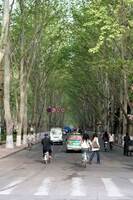- England
- Scotland
- France
- Holland
- Germany
- Italy
- Spain
- Portugal
- USA
- China
- Japan
- India
- Iran
- Advice
- Gardens
- England
- Scotland
- France
- Holland
- Germany
- Italy
- Spain
- Portugal
- USA
- China
- Japan
- India
- Iran
- Advice
- Garden Tours
Book: Landscape Planning and Environmental Impact Design: from EIA to EID
Chapter: Chapter 10 Sustainable green transport
Avenues were a central feature of baroque city planning [Cross ref to Fig in Ch 2]. Rome, Paris, Berlin and Washington DC have magnificent avenues. They were designed for aesthetic, transportation, ceremonial and military purposes. As design features, they resemble the dramatic entrances to important buildings. Avenues help travellers to find their way and give them a theatrical sense of occasion. Yet the avenue was jettisoned by modernist highway planners. They saw it as a functional irrelevance with no justification. To the science of highway engineering, avenues are a waste of money. But the transport planners' true clients are citizens, not government regulations or members of local transport committees. What good citizens want is good cities. It is, therefore, time to re-invent the broad straight tree-lined road. Avenues can intensify the majesty of a metropolis and give dignity to a small town. No functional modern road can stand comparison with the grand avenues of Paris or Washington, with The Ringstrasse in Vienna, or with Princes Street, The Mound and Moray Place in Edinburgh. Nor have we made any dignified high streets, winding roads or country lanes of the type which attract visitors to English villages. In Bracknell New Town, the old village high street was demolished and rebuilt, at great cost, as a windswept shopping mall fronted by modern buildings (Parris & Parris 1981: 32). Rasmussen was amazed at the waste of land on road space in Harlow New Town and questioned the design team about it in the 1950s: 'One of the planners apologetically said to me that it was caused by the road engineers' exorbitant demands... I must confess that it shocked me that when planning eight new towns there was no time to discuss such fundamental principles' (Rasmussen 1982: 439).
